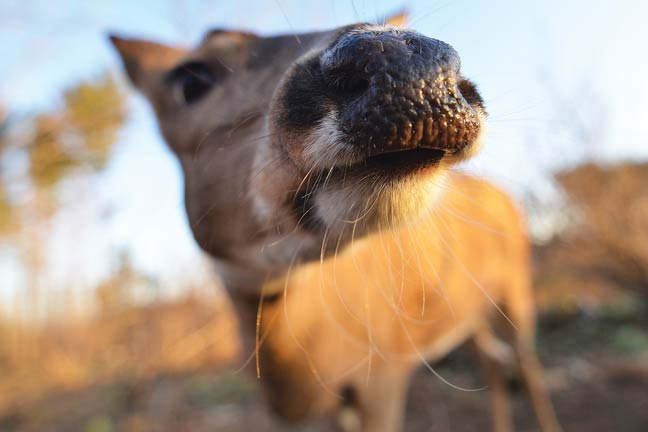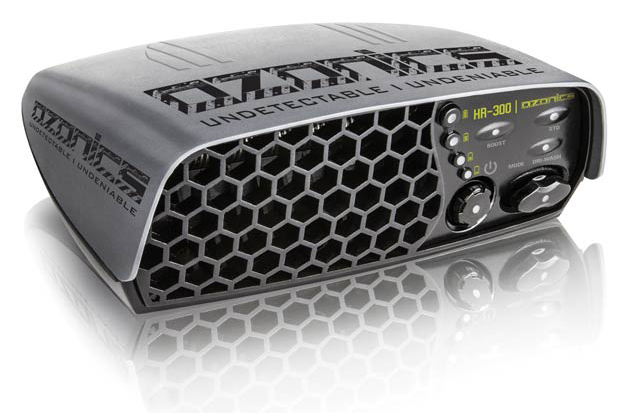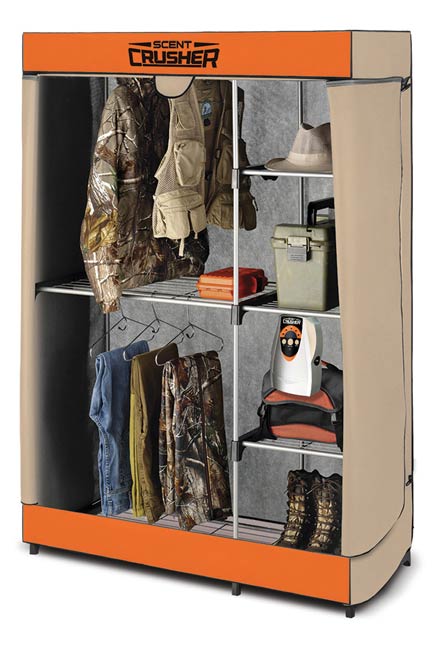November 02, 2016
By Gary Socola
Every so often, along comes a product category with the potential to revolutionize whitetail hunting. By "revolutionize" hunting, I mean to "transform it to a point the majority of hunters use the product."

Portable tree stands, grunt calls, compound bows and modern camouflage patterns are among the types of products to have achieved this status.
I think products that generate ozone to defeat a deer's sense of smell now have the potential to join them. How? To answer that, we first need to know what ozone is.
Advertisement
Ozone was first reported in 1785. In 1840 Christian Schönbein, a professor at the University of Basel in Switzerland, identified its odor and named it. He called the new gas "ozone" from the Greek word "ozein," meaning "to smell."
The distinctive smell is the same that occurs during a thunderstorm, during which lightning bonds oxygen molecules together to form ozone in the atmosphere. (Certain wavelengths of sunlight also can form these molecules.)
I know ozone's smell quite well, because my own company validates the proper use of medical devices. We have sterilizers that create ozone as a byproduct or use it for sterilization.Humans have been using ozone in the medical, dental, agricultural, water, food processing, restaurant, hotel and heating-air conditioning industries for many years.
Advertisement
Ozone is a strong, gaseous, oxidizing chemical prone to react with chemicals that have unsaturated molecular structures. It reacts with many volatile organic compounds commonly produced in nature, resulting in either their total destruction or their chemical alteration in such a manner that they lose their characteristic chemical properties — including their smell.
Although ozone itself has a smell, the probability that a deer will detect it, and then react to it, is low. That's because the created ozone only stays in the atmosphere for a short time before changing back to oxygen, typically within a few feet of being generated in the field. Also, as noted, ozone's odor is natural and non-threatening to deer.
My life revolves around deer hunting, whether putting in food plots on my property in my home state of New York or driving to my lease in Iowa. So when ozone technology came onto the market, I knew I needed to investigate its potential for use in deer hunting.
I don't buy a hunting product just because a hunter on TV says it works. I choose to evaluate a product on my own before determining if it's worth adding to my hunting strategy.

I later bought an HR-200 Scent Eliminator by Ozonics.
According to the company's website, "The HR-200 transforms oxygen molecules into ozone molecules and, with a silent fan, projects them downwind out over your scent zone, where these unstable molecules bond with your scent molecules . . . the heavier ozone molecules fall through your scent zone. Because ozone molecules are extremely unstable, they bond with any molecule they come near (scent molecules), rendering them indistinguishable to the nose of the deer."
In a nutshell, ozone can eliminate all forms of bacteria, fungus, mildew, mold, chemicals and other sources of odor. That includes human scent from breath, hair, armpits, groin, feet, etc.
How well does it work? Shortly after receiving the HR-200, I bought a used Dodge Durango. I told the salesman I wouldn't purchase a smoker's vehicle, but somehow that's what I ended up with.
While test driving the SUV, all I smelled was an air freshener — but after buying it and driving for a week, I noticed the smell of cigarettes.
I contemplated selling the Durango but instead decided to give the HR-200 a try. I placed the unit within the cab and turned it on. Six hours later, the cigarette smell was eliminated. What's more, the vehicle has since remained free of cigarette odor.
"These incredibly powerful molecules (ozone) literally destroy organic odors, including human body odor, cigarette smoke, musty storage totes, cooking and even gasoline," notes Scott Matheson of Whitetail'R, which manufactures the ScentPURG line of products (whitetailr.com). "Smells aren't just covered up — they're gone for good."
This process is clearly different from having odors masked by cover scents, neutralized by scent-elimination products or having the odor adsorbed, as occurs with carbon technology. I personally use all of these product types and will continue to do so. They all have their limitations, just as ozone technology does, but we'll cover that later.
Two types of ozone products are available to hunters. The first is an "ozone generator," which is placed in a confined space such as a bag, container or cabinet. Clothes and other items are placed inside, and the unit is turned on to create ozone. After the proper exposure time, the items are retrieved and worn/used while hunting. The hunter should still use normal scent-reduction measures, but pre-hunt clothes and gear should now be as scent free as possible.
The second type of treatment involves an "in-the-field" ozone generator, which actually can be used while hunting. This type of product is typically placed 8-12 inches above the head while in a tree stand. The product can also be used in confined spaces to treat clothes and gear prior to the hunt.
Ozone can be especially helpful for bowhunters, because of the relatively close distances dictated. Pre-hunt treatment of gear helps you avoid tipping off a deer's olfactory sense when entering or exiting a stand site, and that's critical, of course, when hunting wary bucks. How many times has a deer reacted negatively when it came across the entry trail you used to reach your stand?
By implementing an "ozone scent wash station," a hunter can greatly reduce his or her scent presence while hunting. This station might be inside a closed bag, a vehicle or a cabinet.
After treating hunting clothes, daypacks, backpacks and other equipment, a hunter should continue to apply his or her normal scent-elimination products to help control odor made from the time clothes are put on to the time the person reaches the stand. Treating clothes/gear before the hunt with ozone is effective, but the ultimate strategy also includes generating ozone in the field.
Matheson says the ScentPURG 270+ ozone generator has been selling well because the "biggest trend we are seeing with our customers is those building their own storage cabinets, closets and even rooms to store and treat all their hunting gear."
He cautions users not to make the cabinet airtight, however, as airflow is required to move the heavy ozone molecules from the top through the articles inside the cabinet.

MoJack Distributors, carrier of Scent Crusher products, has introduced two models of storage closets. The Ozone Hunter's Closet is easy to set up anywhere you need to store hunting equipment and clothing. Like the company's other products, it uses ozone to safely kill harmful bacteria and reliably eliminate odors.
"Our team has worked thousands of hours with top ozone experts to develop easy-to-use products to really kill odors, not just cover them up," says Dan Drake, MoJack's CEO. "Through the use of ozone, 99.99 percent of the bacteria and viruses that can cause odors can be eliminated."
Is ozone safe? It can have negative effects in high concentrations but generally isn't harmful at low concentrations. Here in the U.S., there are federal safety standards for human exposure.
The Occupational Safety and Health Administration's permissible exposure limit over an 8-hour total weight average (TWA) is 0.1 parts per million (ppm). TWA is the average airborne exposure in any 8-hour period of a 40-hour workweek.
"Outdoors, it is virtually impossible to exceed these federal standards," Ozonics claims on its website. "Indoors, if there is ventilation (air movement), it is also virtually impossible to exceed these federal standards."
Don't confuse air-quality ozone warnings issued by state health departments with the way in which we hunters use ozone. Those warnings are for automobile exhaust and out-of-state emission sources (such as wildfires), which are the primary sources of unnatural levels of ground-level ozone.
But just as some people are allergic to peanut butter, some are sensitive to ozone.
According to Ozonics, "The symptoms of this sensitivity vary from eye and/or throat irritation to light-headedness, but they are temporary and disappear when the ozone is removed. The symptoms aren't fatal in nature, although federal standards recommend those with heart or lung conditions not utilize ozone-generating products. Ozonics doesn't produce enough ozone to be dangerous to human health unless it is seriously misused."
Ozone exposure can cause dryness of the mouth, coughing and irritation of the nose, throat and chest. Sensitive hunters might notice this more while hunting from an enclosed blind than when hunting from a tree stand. If this reaction occurs, you might be a bit too close to the source of the ozone.
Turn off the device until the symptoms are alleviated, then reposition the unit prior to turning it back on to see if the irritation goes away. (Some in-the-field ozone units have two settings: one for use in blinds and the other for tree stands.)
Some deer hunters say they're concerned about the noise the fan in a generator makes. On calm, crisp and cool days I can hear the fan motor running up close, but it doesn't appear to spook deer.
The biggest limitation I've noticed while hunting is battery life. Toward the end of October and into early November, I hunt all day.
The normal battery sold in some units won't last from before dawn until the end of the hunting day, so I bought an extended-life battery. By using both, I'm able to run the unit all day long.
I applied my new ozone strategy last fall, and it was the most productive season of trophy hunting I've had in 37 years of chasing whitetails. I harvested two mature bucks just six days apart. The first fell in my home state of New York and the second in Iowa, where it had taken me three years of preference points to receive a coveted tag.
In Iowa, I logged 160 hours of stand time using Ozonics, and the results were impressive. I had numerous deer, coyotes and red foxes downwind of my stands, but none detected me.
On windy days, (20 mph or more) or ones with swirling winds, the animals were a bit more wary, but none actually spooked. On these days I moved the HR-200 closer to my body (4-6 inches above my head), minimizing the issue.
When seven does passed my tree at 15 yards, I knew my strategy was working. All passed my stand quietly until the matriarchal doe decided something was out of place. She began head bobbing and traveled downwind to identify what was making her uncomfortable.
Soon several other mature does also were downwind of me. After 10 minutes, all lowered their guard and began feeding off down the trail, staying downwind and in sight for another 20 minutes without spooking.
After 2 1/2 weeks of bowhunting Iowa, constraints at work and the Thanksgiving holiday forced me to leave empty-handed. It was now firearms season back in New York, and there I found myself watching a block of timber on a ridge between two bedding areas.
After dawn a small 7-pointer came from directly downwind, never smelling me. He stopped at an oak 100 yards away and began crunching on acorns.
Suddenly, a large deer stepped out of the bedding area and began posturing toward the other buck. The 7-pointer assumed a submissive posture and backed away. I could now see the intruder was a mature buck just begging to be called in. I pulled out my Primos grunt call and blew a sequence.
The big 10-pointer stopped and began walking toward me. He finally paused and gave me a broadside shot. The deer traveled just 30 yards after the crack of my .270 Rem.
Six days later, I was back in Iowa. There I sent a Muzzy-tipped Easton through a big 9-pointer that had eluded me earlier. It had taken me 1,095 days to draw my Iowa tag and 17 full days of hunting to fill it.
I knew my ozone strategy that season had paid off big — especially in Iowa, where the buck was downwind of me when I released my arrow.
With the correct ozone strategy, you should see a decrease in the number of times deer detect you by smell. You'll open up tough-to-hunt locations that are awesome hotspots but only give you the correct wind for hunting them perhaps once or twice a year.
These setups can include ridgetops, sidehills and bluffs where winds swirl or thermals play havoc with your scent. The ability to hunt these spots more often without tipping off deer is a tremendous advantage and should result in more venison in the freezer and racks on the wall.
So will ozone products actually revolutionize deer hunting? In terms of the number of users, they haven't so far. But I feel they have that potential. All I'm sure of is that I'll be using ozone for as long as the good Lord allows me to continue hunting whitetails.
